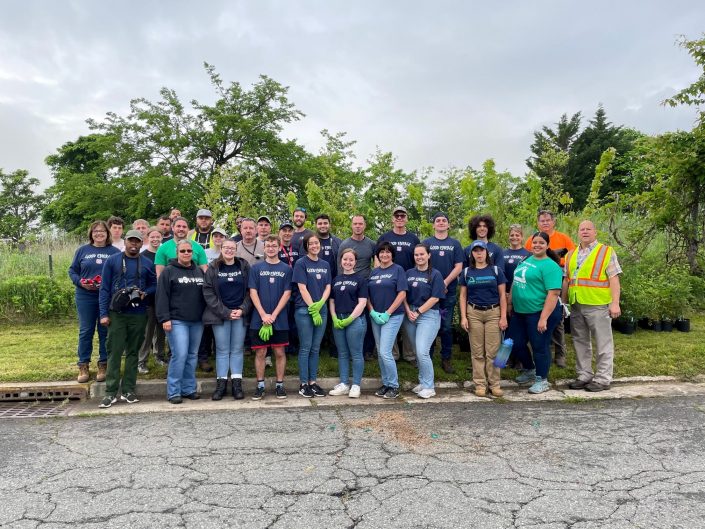Protecting Flood-Prone Communities Through Wetland Restoration
by Christine Healy

Hurricane Ida. Hurricane Irene. Superstorm Sandy. These weather events represent three of the four most devasting storms recorded in New Jersey history. Though data dates back 218 years, all 3 have occurred within the past 11, substantiating concerns over the effect of climate change on tropical cyclone severity. Therefore, taking measures to safeguard communities from devastating floodwaters is more important now than it ever has been. But who said helping people can’t, in turn, help wildlife?
The New Jersey Department of Environmental Protection (NJDEP) runs a program called Blue Acres in which they purchase homes on low-lying parcels of land, located in flood zones, demolish them, and preserve the lots in perpetuity. The idea is that these formerly developed locations can shield surrounding neighborhoods from inundation, thus reducing the risk associated with dangerous storms. One Blue Acres site, located in the Tremley Point district of Linden, is trying a novel approach. With the help of Superstorm Sandy grant funds from – EPA and private corporate partners – Phillips 66 Bayway Refinery – funding was made possible to complete woodland and wetland restoration on state-owned land purchased under the Blue Acres program. The project initiative dates back to 2014 and a diverse group of initial partners (USFW, Rutgers Engineering, City of Linden, Princeton Hydro, NJCWRP, and EnviroScapes) worked together to see the Tremley Point Floodplain project become a reality – one of the 1st in the state. More recently, CWF has joined the team in making sure the Blue Acres site in Linden is protected from invasive species and that ongoing maintenance of the landscape continues to support a functional wetland and upland forest buffer. On June 3, CWF joined the collaborative work team of 45 people, that came to replant trees and shrubs and weed deer protected cages of the Blue Acres site. The team included: Phillips 66 Bayway Refinery, Infineum USA, City of Linden, Groundwork Elizabeth, the community, and CWF.
Though wetlands have a long history of being unappreciated and underestimated, they provide countless ecosystem services, supporting local communities, the economy, and the planet at large. Their characteristic soils- hydric soils- are especially adept at absorbing and containing influxes of water. As water levels recede, hydric soils discharge water particles slowly, allowing them to return to their source gradually while causing minimal erosion. Non-hydric soils, like those underlying suburban lawns, are not nearly as effective at holding water, and provide streams and structures with minimal protection against degradation and destabilization. Grasses found in residential areas leach nutrients from the soil, necessitating the application of chemical fertilizers in order to persist, which can then impair ponds, lakes, and rivers; however, native wetland plants capture these pollutants that enter our water system, acting as a natural sieve. Through this filtration process, nutrients that can deplete dissolved oxygen and cause mass die-offs of fish and other aquatic animals are removed from the water. Further, wetlands are sinks for carbon and other greenhouse gases, and are working hard to buy us time to innovate and inspire the change necessary to address our climate crisis. Forest buffers enhance a wetland’s ability to perform these functions.

All of these services are imperative; however, one of the wetland functions that we’re most interested in at CWF is the crucial habitat that they provide for a huge diversity of wildlife. New Jersey is a destination for birders because our wetlands are geographically convenient and productive enough to provide migratory birds with sustenance on their long voyage to and from breeding grounds. Seven of our local amphibians could not carry out their lifecycles without accessibility to ephemeral wetlands. Bog and spotted turtles require wetland ecosystems, while many other species bask and feed on the abundant insect populations that get their start in the safety of wetland waters. The complexity of edge habitat affords birds, amphibians, reptiles, and mammals refuge from predators and shelter from the elements. Where wetlands are flourishing, wildlife will be as well.
Rebuilding a wetland takes time, patience, and a lot of collaboration. The planning and permitting work began in 2014, and construction of the Linden Floodplain restoration began in 2020. Maintenance and evaluation will continue until the habitat becomes established. A team of volunteers from Phillips 66 Bayway Refinery, Infinium USA L.P., Groundwork Elizabeth, EnviroScapes, the City of Linden, local community, and CWF were out on June 3,- planting trees and removing invasive and unwanted vegetation that were crowding out native flora. In the future, we plan to stabilize Marshes Creek, a tributary of the Rahway River that flows through the property, with flood-tolerant saplings and continue to improve the area with wildlife in mind. It is our hope that, one day, this Blue Acres site will offer refuge and sanctuary to a diverse community of plants and animals, while providing Tremley Point with priceless ecosystem services.





Discover more from Conserve Wildlife Foundation of NJ
Subscribe to get the latest posts sent to your email.